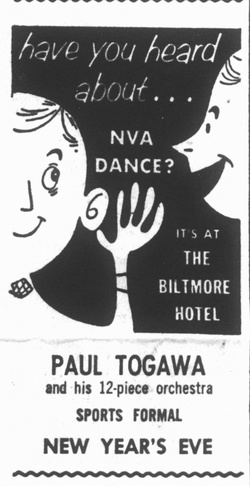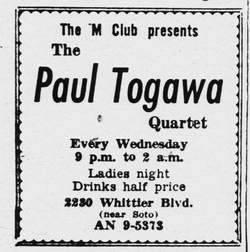As part of my ongoing series on Japanese American jazz musicians, I now turn to the fascinating story of Paul Togawa. Although most of the previous musicians I have showcased were all Nisei born in the 1920s, Togawa was a rare exception as a postwar Nisei who developed a successful career at a young age.
As a jazz drummer who led his own orchestras and cut several records— one among few Japanese Americans, along with Tak Shindo, who did so in the 1950s—Togawa rose quickly to the top of the Los Angeles jazz scene. By the end of his career, Togawa had made several appearances on primetime television, performed with the likes of Miles Davis, Art Pepper, and Quincy Jones, and produced two LPs. Additionally, he found time to appear as an actor playing bit roles in prominent films like Alfred Hitchcock’s North By Northwest and Robert Pirosh’s Go For Broke!.
Paul Susumu Togawa was born on in Los Angeles on September 3, 1932. Togawa was the second child of Akira and Kimi Togawa. Akira Togawa was an Issei poet who established himself within the Los Angeles literary scene. Together with his wife Kimi, they ran a grocery store.
Growing up, Togawa learned Japanese from his parents and picked up Spanish from his friends in Boyle Heights. His language skills became helpful in his future acting career, allowing him to traverse various roles.
In May 1942, at the age of 9, Togawa and his family were sent directly to the Poston Concentration Camp 1 near Parker, Arizona. It was in camp that his love of music began. Jazz historian George Yoshida argues that Togawa “first tasted the exquisite flavor of jazz in the Poston Detention Camp.”
In a later interview, Togawa said that it was thanks to a Maryknoll priest -Father Clement Boesflug - who visited the camp and lent him a trumpet. For four months, Father Clement taught Togawa how to play until Boesflug left the camp for duties elsewhere. Despite his early training on trumpet, Togawa ultimately switched to percussion.
In September 1945, the Togawa family returned to Los Angeles from Poston camp. The following year, Paul then enrolled in Theodore Roosevelt High School. While in high school, Togawa continued to play the drums for the school band, and played the snare drum for the school’s Junior ROTC.
Even as an adolescent, Togawa showed promise as an exceptional jazz drummer. He performed at several Nisei Week festivals with his orchestra. On August 24, 1950, Togawa and his combo performed at the Koyasan Temple for the annual Nisei Week festival. The combo performed the jazz standards “Body and Soul” and “Stormy Weather,” with Chickie Ishihara on vocals.
In June 1950, Togawa graduated from Theodore Roosevelt High School in Boyle Heights, Los Angeles. He then enrolled in East Los Angeles Junior College (now Cal State LA) and studied business. Shortly thereafter, he dropped out to join Lionel Hampton’s orchestra.
Hampton took a particular interest in Togawa as a fellow percussionist (Hampton often led the orchestra while playing the vibraphone). As part of Hampton’s group, Togawa played the trap set, bongos, congas, and various auxiliary percussion. Hampton regularly featured Togawa as part of a “Spanish” novelty act, where Togawa and the band performed rhumba, samba, and other Latin American styles.
Hampton’s band toured across the United States, with several tours in the Deep South. Togawa later recalled that those tours were “a kick…[I] learned much about race relations and its complexities.” Togawa performed with the Hampton’s orchestra at President Eisenhower’s Presidential Inaugural at the White House in January 1953.
While his music was most important to him, playing music did not pay the bills, so Togawa took to acting to make a living. His first important role came when he was cast as a lieutenant in the 442nd Regimental Combat Team in the the hit 1951 film Go For Broke!
In the years that followed, he continued to perform as a bit-part actor, with appearances in films such as Up Periscope, Alfred Hitchcock’s North By Northwest, The Battle of the Coral Sea, Hell to Eternity, and Flower Drum Song. In 1963, Togawa appeared in an episode of the TV series McHale’s Navy as a mechanic.
Most of the time, Togawa took on roles as Japanese, that were often stereotypically “oriental” in nature. Togawa said that at one point in his career, “It seems that every time the movie companies want someone to play the ‘enemy,’ I get a phone call.” He even boasted that in one war movie he had played seven different roles, as a soldier eating, playing, marching, crawling, and fighting.
In March 1953, Togawa was conscripted into the US Army. He completed basic training at the Ordnance Replacement Training Center in Aberdeen Proving Ground, Maryland, and later joined the Sixth Army Band. The band performed at several West Coast bases, such as Camp Irwin and Fort Ord in California, and Fort Lewis and Fort Hanford in Washington.
In the March 18, 1953 issue of The Evening Sun, Togawa recounted his life before Army service. He claimed to have served in “six armies:” five of them as an actor, and one in real life.
On July 29, 1954, while stationed at Fort Lewis, Washington, Paul married Carmen J. Delma, an African American woman, in Seattle. The couple had several children: Paula, Teresa, and Christopher Togawa.
In 1955, Togawa completed his army service and returned to Los Angeles, where he continued to perform with Lionel Hampton. In the African American newspaper The Pittsburgh Courier, Togawa was described as Hampton’s “protégé” and the “top Nisei drummer.”
A year later, Togawa left the Hampton orchestra to begin his own band. Dubbed The Paul Togawa Quartet, the group included famed alto saxophonist Gabe Baltazar, pianist Dick Johnson, and bassist Ben Tucker.
In 1957, The Paul Togawa Quartet secured a record deal with jazz label Mode Records (now owned by VSOP records). The group’s self-titled LP included several original tracks, such as “Oriental Blues,” along with some regular jazz standards. The record deal, along with Baltazar, a Filipino American, being a part of the group, made Togawa’s Quartet one of the first Asian American bands to work with a major label.
The LP received mixed reviews. Downbeat awarded the album two and a half stars. In their review, Downbeat declared that “although Togawa’s name is on the record, this date essentially is Baltazar’s.” In a lukewarm assessment, the review concluded that Togawa’s ensemble “is professional…[but] it is possible to be professional without being significant and Togawa is the victim of the race to flood the market with LPs by every contracted group. Perhaps in time this group will make a valid contribution to the field of recorded jazz.”
The review did not stop Togawa from performing. In fact, Togawa continued to be a regular mention in the pages of Downbeat magazine for the next few years. On May 27, 1957, the Quartet appeared with vocalist Chris Connors on the ABC show Stars of Jazz. The quartet made three appearances on show, including for the final episode when it aired on January 5, 1959.
As part of their coverage of the show, several newspapers related Togawa’s biography and his ability to take “Japanese musical themes” and incorporate them into American jazz. Several praised his use of using traditional Japanese instruments like the koto in his jazz albums.
Gabe Baltazar later went on to a long career as a saxophonist with Stan Kenton’s band. In the 1960s, Togawa’s reorganized his quartet in a trio, with Joe Sample on organ and Bill Plummer on string bass. The group performed regularly at various Japanese American nightclubs, such as the Tai-Ping Restaurant on South Crenshaw and The Flower Drum on North Highland, and was featured on the jazz radio station KNOB-FM (97.9).
In 1964, Togawa recorded a second album with his trio. Titled “The Paul Togawa International Trio,” the LP was a combination of traditional Japanese songs, blues, and was produced by Musifon Records. On May 21, 1964, the group performed a medley of Japanese and American tunes and the standard “A Quartet is a Quartet.”
Sometime later in 1964, Togawa dissolved his trio and left the United States for East Asia, where he spent several years performing in the club circuits in Japan, the Philippines, South Korea, and Thailand.
During the 1970s, after returning from East Asia, Togawa’s career began to slow down. In May 1971, Togawa performed at the Surfrider club in Santa Monica in a quartet with piano legend Hampton Hawes, saxophonist Tony Ortega, and bass player Leroy Vinnegar.
Later that year, he performed with his quartet and Nellie Lutcher’s Quartet at the Los Angeles County Fall Jazz Festival. It would be one of his last professional gigs; in an interview with George Yoshida, Togawa recalled that he gave up gigging around 1971. From then on, Togawa worked as a Toyota salesman at several dealers, such as Jack Poet Toyota on South Figueroa and Venice or Wondries Toyota in Alhambra, often showcasing his linguistic skills in Japanese and Spanish.
In his later years, Togawa’s name fell into obscurity. On occasion, writers like George Yoshida and Wimpy Hiroto recalled Togawa’s impact on the jazz scene in their works. Paul Togawa died on April 20, 2018. He was survived by his children and his wife of thirty years, Betty Paps. His obituary was later featured in the Los Angeles Times, and highlighted his and Gabe Balthazar’s legacy as pioneering Asian American musicians.
Although Togawa is no longer a household name, his name still rings out among jazz enthusiasts. While several Nisei jazz musicians achieved stardom at different points in their career, few left a lasting impact like Togawa.
© 2023 Jonathan van Harmelen









